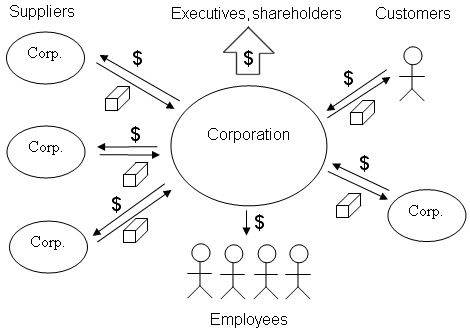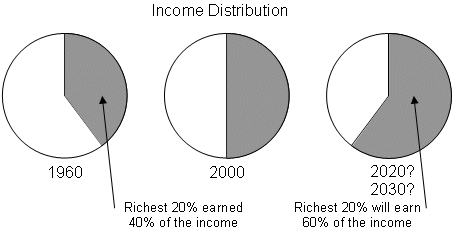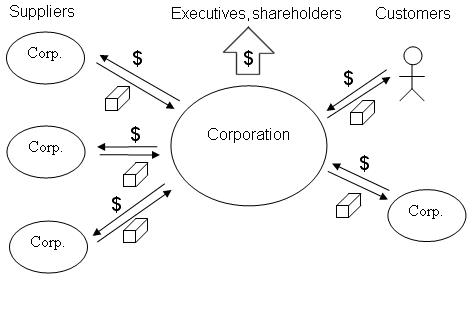Chapter 6 – The Concentration of Wealth
by Marshall Brain
What happens economically as all of these new robots move into the workforce and start taking jobs? What happens as the process accelerates and tens of millions of workers become unemployed and unemployable? As the truck drivers, checkout clerks, waitresses, construction workers, maids, janitors, etc. all lose their jobs, what happens to all of these displaced workers? And what happens to all of the money that used to be paid to them in wages?
We can look back over the past 30 years and see exactly what will happen. There has been a consistent trend of income inequality over the past three decades, and that trend will accelerate as robots take over jobs in increasing numbers. The money paid to CEOs and executives will increase while the money available for everyone else shrinks.
The trend toward the concentration of wealth happens on many different fronts, so let me give you an example. I have personally been able to watch the effect that the Apple iPad has had on one industry.
If we were to go back in time just a few years, the iPad did not exist and the amount of automation in an airplane’s cockpit was low, especially for private airplanes. Pilots relied universally on large paper maps printed by the FAA to get from point A to point B. In fact, the FAA required that pilots carry current versions of the paper maps to cover every part of their intended route. These maps are important because they contain a wealth of information – everything from radio frequencies used by airports and VOR beacons to the position and height of all of the towers that a pilot might run into.
Then the first iPad appeared in 2010, and several entrepreneurs realized that they could take images of the FAA charts and load them into an iPad. Inside the iPad, the charts would be smaller, easier to update and far more useful. For example, it would be easy for an iPad with a GPS receiver to show the pilot his/her exact location on the chart.
The thing that happened next with the FAA’s paper charts business is representative of the job compression that is taking place throughout the economy. In 2010, and for many decades prior, the paper charts business was a nice little enterprise for the FAA and local airports. The FAA ran a whole printing plant with presses, paper, ink, cutters, forklifts, packaging equipment, etc. along with dozens of employees. The maps would get sent to hundreds of small, local pilot shops and airports, each of which could support employees through the sales of the charts. There were also employees at the factory that made the printing presses, and more employees at the ink plant, the paper plant, the forklift plant. Then there are the shipping companies moving all of the equipment, supplies and maps around.
Along comes the iPad. No one needs paper maps anymore. So the printing plant at the FAA will close, along with all of the related jobs at the plant. All of the shops selling paper maps lose that source of revenue and lay off hundreds of workers. The demand for paper, ink, printing presses and fork lifts goes down, so jobs are lost there too. And there is far less shipping involved.
Yes, jobs do get created at tiny iPad app companies. These are the knowledge worker jobs, primarily for computer programmers. None of the people who used to run presses, forklifts, cutters, trucks or shops will ever be writing code for apps, and the compression rate is 10 to 1 or more. In other words, something like 10 jobs are lost for every new job created.
That same kind of job compression is happening through so many sectors right now – newspapers, magazines, books, etc. It is about to happen in restaurants, as tablets and kiosks start replacing wait staff. When computer vision becomes available, a stupendous number of jobs will be lost through a similar process. It is an amazing trend.
As you think about these trends, you may be coming to a new realization. We are standing right now on the threshold of the robotic era. Once robots start arriving in the job market in significant numbers – something that we will see happening within a decade or so – they have the potential to dramatically change the world economy.
At least 50 percent of the people working in the American job market today are working in people-powered industries like fast-food restaurants (McDonald’s, Burger King, Wendy’s, etc.), retail stores (Wal-Mart, Home Depot, Target, Toys “R” Us, etc.), delivery companies (the post office, Fedex, UPS, etc.), construction, airlines, amusement parks, hotels and motels, warehousing and so on. All of these jobs are prime targets for robotic replacement.
Today we are seeing the deployment of automated checkout lines in stores across the U.S. This is the leading edge of the robotic revolution in retail. We will start to see voice-recognizing robots helping customers in these stores, inventory-shelving robots putting the products out, cleaning robots sweeping the floors and the parking lots, cart robots bringing the shopping carts back into the store…. Robots will be moving in to make the completely automated retail store a reality in the not-too-distant futue. Companies like Wal-mart, K-Mart, Target, Home Depot, Lowes, BJ’s, Sam’s Club, Toys R Us, Sears, J.C. Penny’s, Barnes and Noble, Best Buy, Office Max, Staples, Office Depot, Kroger’s, Winn-Dixie, Pet Depot, etc. will all switch to robots at approximately the same time. They will dump 10 million or more workers onto the unemployment rolls at approximately the same time. Other industries like fast food, construction, transportation, warehousing, etc. will be automating as well, dumping millions more. The unemployment rate during this period of time could be remarkable.
New job creation is highly unlikely, because we are creating a second intelligent species that competes directly with human beings in every job category. The economy will have no need for all of these displaced workers. The economy has been primarily creating millions and millions of low-paying, no-benefits, service-sector jobs for the last 40 years. These jobs are perfect for robotic replacement. There is no reason to expect that the economy will suddenly figure out a way to create high-paying, exciting, fulfilling jobs for these tens of millions of people displaced by robots. If the economy could do that, it would be doing it now. We never hear people talking about a robotic scenario that creates jobs.
In other words, The first wave of real robots – robots that can really see and manipulate things in “normal” human environments like a retail store – has the potential to make things very uncomfortable for the American economy. In the not-too-distant future, the rate of economic change will be startling. At the very least it will be a time of intense flux and employment turmoil.
How are we, as a society, going to respond to this robotic revolution? If we handle it properly, the arrival of robots could be an incredibly beneficial event for human beings. If we do not handle it properly, we will end up with millions of unemployed people and a severe economic downturn that will benefit no one. Can we modify the American economy now to prevent this downturn? Are there things that we can do today to smooth the transition?
The Concentration of Wealth
If you look at our economy as a whole, you can understand why robots have the potential to be so disruptive if we do not handle their arrival properly. Here is a highly simplified view of a typical business, be it a fast food restaurant, a retail chain, etc.:
This diagram shows that a corporation takes in raw materials from suppliers on the left. Using its own assets (factories, stores, offices, equipment, etc.), its employees and its executives, the corporation produces a product or a service. The corporation sells its products and services either to retail customers (people), or it acts as a supplier for other corporations. It then pays its employees for the work they do and sends the profit to the shareholders.
The thing that you notice in this diagram is how important people are to this system. People are where all the money comes from and where all the money goes. When money comes into a corporation, its original source (even if it has passed through several corporations along the way) is a person who spent money. When money leaves a corporation, eventually it pays a person in the form of a wage, a dividend or a benefit.
One thing that has been happening in the economy for quite some time is the concentration of wealth. To put the concentration of wealth into perspective, you can look at a report like the Census Bureau’s: Money Income in the United States. [ref] This report shows that:
- 80 percent of the households in America make 50.6 percent of all the income in America.
- The richest 20 percent of the households, on the other hand, make 49.4% of the income.
In other words, the richest 20% of the people in the United States get half the income. The other 80% get the other half. In the 1960s, the split was closer to 60/40, with 80% of the population making 60% of the income, and the richest 20% of the population making 40%. [ref] Between 1960 and 2000, the income split has gone from 60/40 to 50/50.
In 1960, the wealthiest 20 percent of the U.S. population took home 40 percent of the nation’s income. By 2000 the wealthiest 20 percent took home 50 percent. In the future the process accelerates.
We see the reason for this trend regularly in the news. CEO and executive salaries are rising at a startling pace. The average CEO of a large corporation now makes between $10 million and $20 million per year. Since 1980, CEO salaries have risen by a factor of 10, and that same trend is increasing all executive compensation. William McDonough, president of the New York Federal Reserve Bank, notes:
“I find nothing in economic theory that justifies this development… I can assure you that we CEOs of today are not 10 times better than those of 20 years ago.” [ref, ref, ref]
This sentiment is reiterated in this quote:
Summers’s analysis of current economic conditions suggests that free market capitalism, as now structured, is producing major distortions. These distortions, in his view, have resulted in gains of $1 trillion annually to those at the top of the pyramid, and losses of $1 trillion every year to those in the bottom 80 percent. [ref]
At the same time, employee wages are stagnant. Sixty percent of Americans make less than $14 per hour today. In her book The Divine Right of Capital, Marjorie Kelly describes the situation this way:
The wealthiest 10 percent of households own about half of all stock — so that minority has a virtual economic majority…. Because corporate revenues represent a bulk of GDP, and the wealthiest own the bulk of corporate equity, running corporations to serve stockholders means running the economy to benefit the wealthy.
You can see the level of economic power held by the wealthy in today’s society, and the reasons for wage stagnation for workers, in this brief excerpt from the book Fast Food Nation by Eric Schlosser:
The fast food industry pays the minimum wage to a higher proportion of its workers than any other American industry. Consequently, a low minimum wage has long been a crucial part the fast food industry’s business plan. Between 1968 and 1990, the years when the fast food chains expanded at their fastest rate, the real value of the U.S. minimum wage fell by almost 40 percent. In the late 1990s, the real value of the U.S. minimum wage still remained about 27 percent lower than it was in the late 1960s. Nevertheless, the National Restaurant Association (NRA) has vehemently opposed any rise in the minimum wage at the federal, state or local level.
Also consider facts like this:
Between 2009 and 2012… The top 1 percent saw their real income grow by 34.7 percent while the bottom 99 percent only saw a 0.8 percent gain, meaning that the 1 percent captured 91 percent of all real income. [ref]
The concentration of wealth both in the United States and the world is increasing rapidly. This video describes the situation in the U.S.:
And this one describes the world-wide situation:
If you do not like these particular videos, you can head over to Google and find plenty of corroborating evidence for the concentration of wealth like this or this, or the collection of articles and links at /r/ConcentrationOfWealth.
With executive pay rising at a rapid rate and the wages of everyone else stagnant, you can see where we are heading. The wealth will continue concentrating, moving toward 40/60 — the richest 20% will make 60% of the income. The people in the richest 20% will get more and more of the income, while rank and file employees get less and less. Then it will move toward 30/70.
Robots will turbocharge the concentration of wealth. Let’s take America’s largest corporation – Wal-Mart – as an example. Wal-Mart currently employs approximately 2 million people. Imagine that Wal-Mart is able to deploy robots over a relatively short period of time and eliminate one million of those employees. With most of the rank and file employees replaced by robots and eliminated from the payroll, all of the money flowing into a large corporation has only one place to go — upward toward the executives and shareholders. The concentration of wealth will be dramatic when robots arrive.
With most of the rank and file employees replaced by robots and eliminated from the payroll, all of the money flowing into a large corporation has only one place to go — upward toward the executives and shareholders. The concentration of wealth will be dramatic when robots arrive.
Meanwhile, the one million displaced employees will flow into a job market that is flooded by robotically-displaced workers. Since all major corporations with large numbers of low-pay employees will be doing the same thing, and with robots competing with humans in every job category, the unemployment rate will skyrocket.
What we see on the horizon is an economic catastrophe brewing. Robots will be taking millions of jobs, and those who become unemployed will have no alternatives. What is the best way to deal with this situation over the next several decades? We will explore one promising solution in the next chapter…
Intro | On Kindle | Go to Chapter 7 >>>
